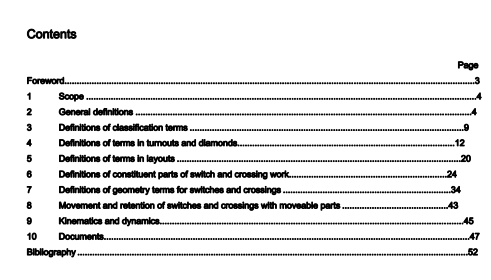BS EN 13232-1:2003 – Railway applications — Track — Switches and crossings — Part 1: Definitions

1 Scope
This European Standard provides an accepted “terminology” for switch and crossing work. With the assistance of diagrams, the various components are given definitions, and these specific names are regarded as obligatory.
The definitions cover the constituent parts and design geometry of switch and crossing work, and include the movement of switches. Additional terminology of a more specific nature will be defined in the relevant part of the series.
The present definitions set out the terms most generally used for the geometrical form and the construction of switches and crossings, omitting those of too special a nature.
2 General definitions
2.1
contact area
those parts of the rail ensuring the support and/or guidance, inside or outside, of a wheel. See Figure 5.
2.2
running table
upper surface of the head of a rail. See Figure 1 .
2.3
running surface
curved surface defined by the longitudinal displacement of a straight line perpendicular to the centre-line of the track and tangential to both running tables. See Figure 2.
2.4
running plane
flat plane tangential to the running surface at the considered point. See Figure 3.
2.5
rail inclination
angle measured as a tangent (e.g. 1 in 20) between the normal to the running surface and the y-y axis of the rail.See Figure 4.
BS EN 13232-1:2003 – Railway applications — Track — Switches and crossings — Part 1: Definitions